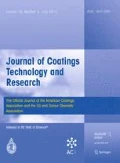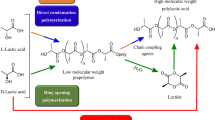Abstract
A UV-curable cardanol-based monomer (ECGE) was prepared using cardanol and epichlorohydrin, followed by epoxidation of the unsaturation in alkyl side chains of cardanol segments. After its chemical structure was confirmed by Fourier transform infrared spectroscopy and proton nuclear magnetic resonance (1H NMR), ECGE was used as a reactive diluent to copolymerize with castor oil-based polyurethane acrylate (PUA) and a series of UV-curable coatings were prepared. Results showed that the viscosity and volume shrinkage of the UV-curable PUA system decreased significantly after the introduction of cardanol-based monomer while maintaining reasonably high bio-renewable contents; when containing 50% of ECGE, the biomass content reaches 66.2%, which is 1.41 times that of pure resin. In addition, the coating properties were evaluated to determine hardness, adhesion, flexibility, and water resistance. The properties of UV-curable thermoset were also studied using tensile testing, dynamic mechanical thermal analysis, and thermogravimetric analysis. The cardanol-based coatings showed excellent adhesion, flexibility, medium hardness, and enhanced char yield although tensile strength, tensile modulus and glass transition temperatures were somewhat diminished. All these performances can be attributed to the unique architectures of ECGE that combined the structural features of rigid benzene ring and long flexible alkyl chains. The UV-curing behavior was determined using real-time IR, and the results indicated that the conversion of unsaturated bond was increased with more concentration of ECGE.








Similar content being viewed by others
References
Sharmin, E, Zafar, F, Akram, D, Alam, M, Ahmad, S, “Recent Advances in Vegetable Oils Based Environment Friendly Coatings: A Review.” Ind. Crops Prod., 76 215–229 (2015)
Chen, G, Guan, X, Xu, R, Tian, J, He, M, Shen, W, Yang, J, “Synthesis and Characterization of UV-Curable Castor Oil-based Polyfunctional Polyurethane Acrylate Via Photo-Click Chemistry and Isocyanate Polyurethane Reaction.” Prog. Org. Coat., 93 11–16 (2016)
Fu, C, Yang, Z, Zheng, Z, Shen, L, “Properties of Alkoxysilane Castor Oil Synthesized Via Thiol-ene and Its Polyurethane/Siloxane Hybrid Coating Films.” Prog. Org. Coat., 77 1241–1248 (2014)
Chang, C-W, Lu, K-T, “Natural Castor Oil Based 2-Package Waterborne Polyurethane Wood Coatings.” Prog. Org. Coat., 75 435–443 (2012)
Fridrihsone-Girone, A, Stirna, U, Misāne, M, Lazdiņa, B, Deme, L, “Spray-Applied 100% Volatile Organic Compounds Free Two Component Polyurethane Coatings Based on Rapeseed Oil Polyols.” Prog. Org. Coat., 94 90–97 (2016)
Hwang, H-D, Kim, H-J, “Enhanced Thermal and Surface Properties of Waterborne UV-Curable Polycarbonate-Based Polyurethane (Meth)Acrylate Dispersion by Incorporation of Polydimethylsiloxane.” React. Funct. Polym., 71 655–665 (2011)
Black, M, Rawlins, JW, “Thiol–ene UV-Curable Coatings Using Vegetable Oil Macromonomers.” Eur. Polymer J., 45 1433–1441 (2009)
Hwang, H-D, Moon, J-I, Choi, J-H, Kim, H-J, Kim, SD, Park, JC, “Effect of Water Drying Conditions on the Surface Property and Morphology of Waterborne UV-Curable Coatings for Engineered Flooring.” J. Ind. Eng. Chem., 15 381–387 (2009)
Hwang, H-D, Park, C-H, Moon, J-I, Kim, H-J, Masubuchi, T, “UV-Curing Behavior and Physical Properties of Waterborne UV-Curable Polycarbonate-Based Polyurethane Dispersion.” Prog. Org. Coat., 72 663–675 (2011)
Dai, J, Jiang, Y, Liu, X, Wang, J, Zhu, J, “Synthesis of Eugenol-Based Multifunctional Monomers Via a Thiol–ene Reaction and Preparation of UV Curable Resins Together with Soybean Oil Derivatives.” RSC Adv., 6 17857–17866 (2016)
Dai, J, Liu, X, Ma, S, Wang, J, Shen, X, You, S, Zhu, J, “Soybean Oil-Based UV-Curable Coatings Strengthened by Crosslink Agent Derived from Itaconic Acid Together with 2-Hydroxyethyl Methacrylate Phosphate.” Prog. Org. Coat., 97 210–215 (2016)
Saalah, S, Abdullah, LC, Aung, MM, Salleh, MZ, Awang Biak, DR, Basri, M, Jusoh, ER, “Waterborne Polyurethane Dispersions Synthesized from Jatropha Oil.” Ind. Crops Prod., 64 194–200 (2015)
Baştürk, E, İnan, T, Güngör, A, “Flame Retardant UV-Curable Acrylated Epoxidized Soybean Oil Based Organic–Inorganic Hybrid Coating.” Prog. Org. Coat., 76 985–992 (2013)
Liu, R, Luo, J, Ariyasivam, S, Liu, X, Chen, Z, “High Biocontent Natural Plant Oil Based UV-Curable Branched Oligomers.” Prog. Org. Coat., 105 143–148 (2017)
Lalitha, K, Sandeep, M, Prasad, YS, Sridharan, V, Maheswari, CU, Srinandan, CS, Nagarajan, S, “Intrinsic Hydrophobic Antibacterial Thin Film from Renewable Resources: Application in the Development of Anti-Biofilm Urinary Catheters.” ACS Sustain. Chem. Eng., 5 436–449 (2017)
Chang, C-W, Lu, K-T, “Linseed-Oil-Based Waterborne UV/Air Dual-Cured Wood Coatings.” Prog. Org. Coat., 76 1024–1031 (2013)
Yang, X, Li, S, Xia, J, Song, J, Huang, K, Li, M, “Novel Renewable Resource-Based UV-Curable Copolymers Derived from Myrcene and Tung Oil: Preparation, Characterization and Properties.” Ind. Crops Prod., 63 17–25 (2015)
Liu, J, Liu, R, Zhang, X, Li, Z, Tang, H, Liu, X, “Preparation and Properties of UV-Curable Multi-Arms Cardanol-Based Acrylates.” Prog. Org. Coat., 90 126–131 (2016)
Liu, R, Zhang, X, Zhu, J, Liu, X, Wang, Z, Yan, J, “UV-Curable Coatings from Multiarmed Cardanol-Based Acrylate Oligomers.” ACS Sustain. Chem. Eng., 3 1313–1320 (2015)
Liu, R, Zhu, G, Li, Z, Liu, X, Chen, Z, Ariyasivam, S, “Cardanol-Based Oligomers with 'Hard Core, Flexible Shell' Structures: From Synthesis to UV Curing Applications.” Green Chem., 17 3319–3325 (2015)
Dai, J, Ma, S, Liu, X, Han, L, Wu, Y, Dai, X, Zhu, J, “Synthesis of Bio-Based Unsaturated Polyester Resins and Their Application in Waterborne UV-Curable Coatings.” Prog. Org. Coat., 78 49–54 (2015)
Dai, J, Ma, S, Teng, N, Dai, X, Shen, X, Wang, S, Liu, X, Zhu, J, “2,5-Furandicarboxylic Acid- and Itaconic Acid-Derived Fully Biobased Unsaturated Polyesters and Their Cross-Linked Networks.” Ind. Eng. Chem. Res., 56 2650–2657 (2017)
Dai, J, Ma, S, Wu, Y, Zhu, J, Liu, X, “High Bio-Based Content Waterborne UV-Curable Coatings with Excellent Adhesion and Flexibility.” Prog. Org. Coat., 87 197–203 (2015)
Auclair, N, Kaboorani, A, Riedl, B, Landry, V, “Acrylated Betulin as a Comonomer for Bio-Based Coatings. Part I: Characterization, Photo-Polymerization Behavior and Thermal Stability.” Ind. Crops Prod., 76 530–537 (2015)
Auclair, N, Kaboorani, A, Riedl, B, Landry, V, “Acrylated Betulin as a Comonomer for Bio-Based Coatings. Part II: Mechanical and Optical Properties.” Ind. Crops Prod., 82 118–126 (2016)
Liu, R, Zhu, J, Luo, J, Liu, X, “Synthesis and Application of Novel UV-Curable Hyperbranched Methacrylates from Renewable Natural Tannic Acid.” Prog. Org. Coat., 77 30–37 (2014)
Li, K, Shen, Y, Fei, G, Wang, H, Li, J, “Preparation and Properties of Castor Oil/Pentaerythritol Triacrylate-Based UV Curable Waterborne Polyurethane Acrylate.” Prog. Org. Coat., 78 146–154 (2015)
Wang, X, Soucek, MD, “Investigation of Non-isocyanate Urethane Dimethacrylate Reactive Diluents for UV-Curable Polyurethane Coatings.” Prog. Org. Coat., 76 1057–1067 (2013)
Chen, J, Nie, X, Liu, Z, Mi, Z, Zhou, Y, “Synthesis and Application of Polyepoxide Cardanol Glycidyl Ether as Biobased Polyepoxide Reactive Diluent for Epoxy Resin.” ACS Sustain. Chem. Eng., 3 1164–1171 (2015)
Ma, S, Jiang, Y, Liu, X, Fan, L, Zhu, J, “Bio-Based Tetrafunctional Crosslink Agent from Gallic Acid and its Enhanced Soybean Oil-Based UV-Cured Coatings with High Performance.” RSC Adv., 4 23036 (2014)
Acosta Ortiz, R, Garcia Valdez, AE, Aguirre Flores, R, Lozano Palacios, RI, Berlanga Duarte, ML, “Synthesis of a Novel Highly Hindered Spiroorthocarbonate and the Study of its Efficiency to Eliminate the Shrinkage in the Photopolymerization of an Epoxycycloaliphatic Resin.” J. Polym. Res., 22 163–172 (2015)
Liu, D, Liu, F, He, J, Lassila, LVJ, Vallittu, PK, “Synthesis of a Novel Tertiary Amine Containing Urethane Dimethacrylate Monomer (UDMTA) and its Application in Dental Resin.” J. Mater. Sci. Mater. Med., 24 1595–1603 (2013)
He, J, Liu, F, Vallittu, PK, Lassila, LVJ, “Synthesis of Dimethacrylates Monomers with Low Polymerization Shrinkage and its Application in Dental Composites Materials.” J. Polym. Res., 19 9932 (2012)
Voirin, C, Caillol, S, Sadavarte, NV, Tawade, BV, Boutevin, B, Wadgaonkar, PP, “Functionalization of Cardanol: Towards Biobased Polymers and Additives.” Polym. Chem., 5 3142–3162 (2014)
Amarnath, N, Appavoo, D, Lochab, B, “Eco-Friendly Halogen-Free Flame Retardant Cardanol Polyphosphazene Polybenzoxazine Networks.” ACS Sustain. Chem. Eng., 6 389–402 (2018)
Fouquet, T, Fetzer, L, Mertz, G, Puchot, L, Verge, P, “Photoageing of Cardanol: Characterization, Circumvention by Side Chain Methoxylation and Application for Photocrosslinkable Polymers.” RSC Adv., 5 54899–54912 (2015)
Wang, X, Zhou, S, Guo, W-W, Wang, P-L, Xing, W, Song, L, Hu, Y, “Renewable Cardanol-Based Phosphate as a Flame Retardant Toughening Agent for Epoxy Resins.” ACS Sustain. Chem. Eng., 5 3409–3416 (2017)
Liu, Z, Chen, J, Knothe, G, Nie, X, Jiang, J, “Synthesis of Epoxidized Cardanol and Its Antioxidative Properties for Vegetable Oils and Biodiesel.” ACS Sustain. Chem. Eng., 4 901–906 (2016)
Balgude, D, Sabnis, AS, “CNSL: An Environment Friendly Alternative for the Modern Coating Industry.” J. Coat. Technol. Res., 11 169–183 (2013)
Ma, H-X, Li, J-J, Qiu, J-J, Liu, Y, Liu, C-M, “Renewable Cardanol-Based Star-Shaped Prepolymer Containing a Phosphazene Core as a Potential Biobased Green Fire-Retardant Coating.” ACS Sustain. Chem. Eng., 5 350–359 (2016)
Mishra, V, Desai, J, Patel, KI, “(UV/Oxidative) Dual Curing Polyurethane Dispersion from Cardanol Based Polyol: Synthesis and Characterization.” Ind. Crops Prod., 111 165–178 (2018)
Jia, P, Hu, L, Shang, Q, Wang, R, Zhang, M, Zhou, Y, “Self-Plasticization of PVC Materials via Chemical Modification of Mannich Base of Cardanol Butyl Ether.” ACS Sustain. Chem. Eng., 5 6665–6673 (2017)
Wang, X, Kalali, EN, Wang, D-Y, “Renewable Cardanol-Based Surfactant Modified Layered Double Hydroxide as a Flame Retardant for Epoxy Resin.” ACS Sustain. Chem. Eng., 3 3281–3290 (2015)
Bo, C, Wei, S, Hu, L, Jia, P, Liang, B, Zhou, J, Zhou, Y, “Synthesis of a Cardanol-Based Phosphorus-Containing Polyurethane Prepolymer and Its Application in Phenolic Foams.” RSC Adv., 6 62999–63005 (2016)
Hu, Y, Liu, C, Shang, Q, Zhou, Y, “Synthesis and Characterization of Novel Renewable Castor Oil-Based UV-Curable Polyfunctional Polyurethane Acrylate.” J. Coat. Technol. Res., 15 77–85 (2017)
Huo, S, Wu, G, Chen, J, Liu, G, Kong, Z, “Constructing Polyurethane Foams of Strong Mechanical Property and Thermostability by Two Novel Environment Friendly Bio-Based Polyols.” Korean J. Chem. Eng., 33 1088–1094 (2016)
Bo, C, Hu, L, Jia, P, Liang, B, Zhou, J, Zhou, Y, “Structure and Thermal Properties of Phosphorus-Containing Polyol Synthesized from Cardanol.” RSC Adv., 5 106651–106660 (2015)
Sangermano, M, Ortiz, RA, Urbina, BAP, Duarte, LB, Valdez, AEG, Santos, RG, “Synthesis of an Epoxy Functionalized Spiroorthocarbonate Used as Low Shrinkage Additive in Cationic UV Curing of an Epoxy Resin.” Eur. Polym. J., 44 1046–1052 (2008)
Acosta Ortiz, R, Reyna Medina, LA, Berlanga Duarte, ML, Ibarra Samaniego, L, Garcia Valdez, AE, García Mendez, ZL, Mendez Gonzalez, L, “Synthesis of Glycerol-Derived Diallyl Spiroorthocarbonates and the Study of Their Antishrinking Properties in Acrylic Dental Resins.” J. Mater. Sci. Mater. Med., 24 2077–2084 (2013)
Xiao, S, Chen, Q, Chen, M, Hong, X, “Studies on Epoxy-Acrylate Hybrid UV-Cure System.” Chem. J. Chin. Univ., 9 1797–1800 (2002)
Liu, C, Wang, C, Hu, Y, Zhang, F, Shang, Q, Lei, W, Zhou, Y, Cai, Z, “Castor Oil-Based Polyfunctional Acrylate Monomers: Synthesis and Utilization in UV-Curable Materials.” Prog. Org. Coat., 121 236–246 (2018)
Lian, Q, Li, Y, Yang, T, Li, K, Xu, Y, Liu, L, Zhao, J, Zhang, J, Cheng, J, “Study on the Dual-Curing Mechanism of Epoxy/Allyl Compound/Sulfur System.” J. Mater. Sci., 51 7887–7898 (2016)
Stroganov, VF, Stroganov, IV, “Study of the Processes of Epoxyallyl Polymer Formation of IPN Type Upon Curing of Oligomer–Oligomer Mixtures.” Polym. Sci. Ser. D, 5 129–132 (2012)
Acknowledgments
We greatly thank to the Natural Science Foundation of Jiangsu Province (BK20161122), Jiangsu Province Biomass Energy and Materials Laboratory (JSBEM-S-201501), the Fundamental Research Funds of CAF (CAFYBB2017QB006), and the Fundamental Research Funds from Jiangsu Province Biomass and Materials Laboratory (JSBEM-S-2017010) for financial support.
Author information
Authors and Affiliations
Corresponding author
Rights and permissions
About this article
Cite this article
Hu, Y., Feng, G., Shang, Q. et al. Bio-based reactive diluent derived from cardanol and its application in polyurethane acrylate (PUA) coatings with high performance. J Coat Technol Res 16, 499–509 (2019). https://doi.org/10.1007/s11998-018-0128-6
Published:
Issue Date:
DOI: https://doi.org/10.1007/s11998-018-0128-6




